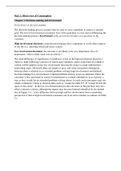Samenvatting
Summary of Chapter 3 - 7 of Consumer Behaviour - Isabelle Szmigin & Maria Piacentini (2018): Micro-view of consumption
- Instelling
- Erasmus Universiteit Rotterdam (EUR)
- Boek
- Consumer Behaviour
Summary of Chapter 3 - 7 of Consumer Behaviour - Isabelle Szmigin & Maria Piacentini (2018): Micro-view of consumption
[Meer zien]






